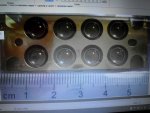I've been considering an array of single mode diodes, I have lots of R,G,B single modes to work with and wanted to do something similar, expanding them and having the expanded beam outputs overlap one another but then I started thinking about just combining them all into a line output. Dreaming more, I thought what if there is a way to convert the line back to something more rounded, hummm.... but the cost and complexity and added losses quickly ended that dream. If you have a solution I'd love to be clued in on it so I can build a nice RGB combined array to produced a white or multicolored fat beam, adjusted to color by which diodes are on. Of course, dichro mirrors can be used but I have like a dozen of each color diodes, so it's more involved than just three diodes.
Lately I've been thinking about knife edging some of the 07E diodes, I have lots of parts already in hand, just need mirrors for blue light. I prefer the prism shaped first surface mirrors because they have such a precision knife edge, very cleanly cut. I've been trying to think how to PBS cube two rows of knife edged diodes and have the PBS cube mounted right in the middle so I can have the output in the right place for expansion right down the center axis of a pointer, but so far I can't seem to envision how to do so yet. I'm about ready to hire an expert to find the solution! I've googled and googled and can't find an example, I suppose the only solution is to add more mirrors and bounce things around until the beam exits down the center of the platform of diodes and mirrors to fit in a pointer. I've also considered fiber, but everyone here tells me it's a real PITA and expensive to get them lined up right, not very suitable for a pointer with all that hardware to deal with, I think. Maybe I shouldn't give up so easily on the idea... I don't mean to get the thread off topic, so I better not continue posting on optics here, I started another thread in the optics section days ago with the PBS in the center question, no one has been able to give any ideas on that yet.








